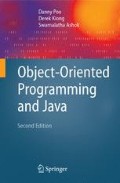Abstract
We have so far discussed the basic facilities for creating objects through Java class definitions and code reuse by inheriting properties of similar but more general classes. In this chapter, we look at the important issue of modularity and the related mechanisms available in Java.
Access this chapter
Tax calculation will be finalised at checkout
Purchases are for personal use only
Preview
Unable to display preview. Download preview PDF.
References
Even if s1.getCount() has been substituted with s2.getCount() in the println() method, the result will still be incorrect.
Author information
Authors and Affiliations
Rights and permissions
Copyright information
© 2008 Springer-Verlag London Limited
About this chapter
Cite this chapter
Poo, D., Kiong, D., Ashok, S. (2008). Modularity. In: Object-Oriented Programming and Java. Springer, London. https://doi.org/10.1007/978-1-84628-963-7_8
Download citation
DOI: https://doi.org/10.1007/978-1-84628-963-7_8
Publisher Name: Springer, London
Print ISBN: 978-1-84628-962-0
Online ISBN: 978-1-84628-963-7
eBook Packages: Computer ScienceComputer Science (R0)

